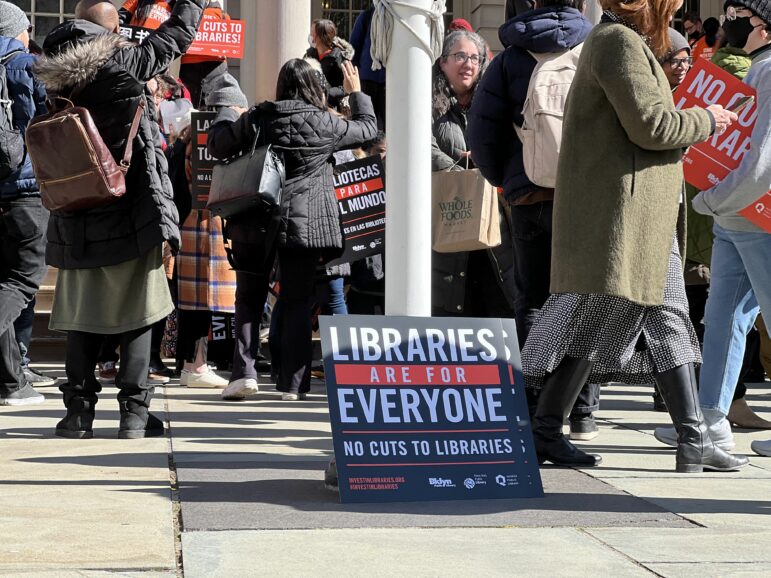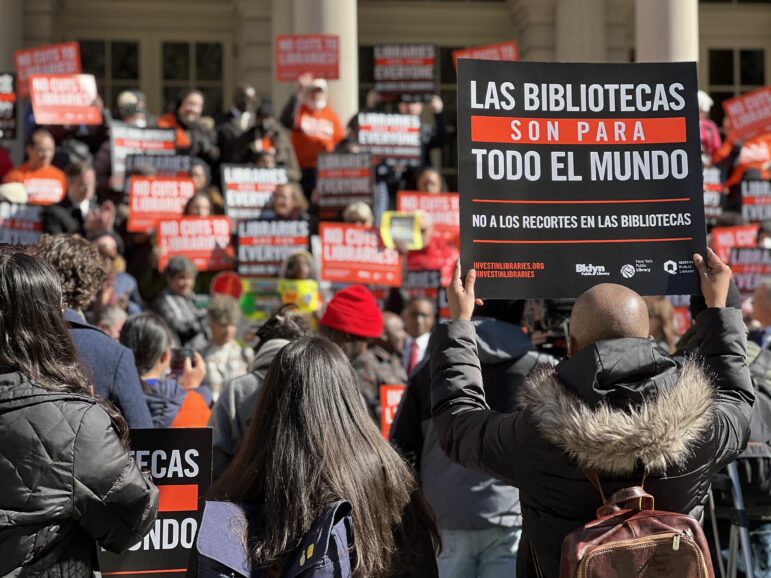Public libraries have long been a refuge for New Yorkers experiencing homelessness, and have emerged as an important resources for asylum seekers in recent months. While Mayor Adams exempted the three library systems from his latest round of belt-tightening measures, they still face a collective $36 million in cuts under his executive budget proposal.

Ryan Pullido
A sign outside City Hall during a rally against library budget cuts on May 20.
At a budget hearing in March, the heads of New York City’s three public library systems testified before City Council members about the ways local branches have pivoted to meet increased demand over the last few years, first in response to the pandemic and more recently, in the wake of a surging homeless population and tens of thousands of asylum seekers who’ve arrived in the city.
The New York Public Library’s branch on East Kingsbridge Road in The Bronx, for example, has seen “lines around the block” of people applying for IDNYC cards, pivotal for new immigrants in need of identification, said NYPL President Anthony Marx. Queens Library regularly sends its traveling “bookmobile” to the city’s homeless shelters, President Dennis Walcott testified; the Rochdale Village branch expanded its English-language classes in response to the “many new emergency shelters” that have opened in Southeast Queens, another library worker said.
“We have seen an enormous number of people since the asylees began [arriving], in Sunset Park in particular in our case,” Brooklyn Public Library President Linda Johnson told lawmakers. “We are filling up backpacks and taking them to shelters so that kids have books.”
But officials say those and other services are threatened by cuts maintained in Eric Adams’ budget proposal, which despite its $106.7 billion price tag, includes a number of belt-tightening measures to counter “slowing” revenue growth and the unexpected costs associated with the asylum seeker crisis, which the mayor said could run as high as $4 billion by the end of the next fiscal year.
“We had to make tough choices in this budget. We had to negotiate competing needs,” Adams said at press briefing when he unveiled his executive budget late last month. “I would love for my libraries to have all the things that they want,” he added. But the city is in “a Maslow’s hierarchy of needs moment—food, shelter, clothing,” the mayor said.
Libraries were spared, somewhat: the mayor exempted the three systems from his latest round of belt-tightening measures, known as the Program to Eliminate the Gap (PEG), but they still face a collective $36 million in budget cuts if the mayor’s proposal is ultimately approved. That includes $20.5 million in cuts the administration announced last fall, and the potential loss of $15.7 million in Council funding.

Ryan Pullido
A rally outside City Hall in March to protest the mayor’s proposed cuts.Library staff and supporters plan to rally Thursday outside City Hall, calling for elected officials to restore funding ahead of a budget hearing on libraries and cultural institutions scheduled that day.
“It is not possible for us to specify how exactly the cuts would affect people who are experiencing homelessness,” a Queens Library spokesperson told City Limits last month. “But there is little doubt that they will affect our services, hours of operation, and collections.”
Public libraries have long been a refuge for New Yorkers experiencing homelessness, said Shams DaBaron, an activist who’s collaborated with the mayor on housing proposals and who was homeless himself, on and off, starting at the age of 10.
“Through the years, it’s become like the only place outside of say, a Starbucks or McDonald’s” where unhoused residents can freshen up, use the restroom, read a book or just come in from outdoors.
“I’ve seen people take advantage of computer literacy classes, financial literacy classes,” he added. “If you’re homeless, you don’t have access to a computer, you don’t have access to Wi-Fi for the most part. And so this is where that becomes that sort of very vital resource for us.”
Just how vital a resource libraries are became starkly apparent during the height of COVID-19, when branches were shuttered for months for most in-person services, said Eileen Clancy, a researcher who studies the digital humanities and access to technology.
During the height of the city’s lockdown measures, she said, she approached several neighbors experiencing homelessness in the East Village where she lives, to see if they needed help connecting online to public benefits as city agencies went mostly remote. “They would say, ‘I just want the libraries to be open,'” she recalled.
Beyond a physical space and access to the internet, libraries have evolved to meet many communities’ needs in recent years, says Lauren Comito of the advocacy group Urban Librarians Unite, which represents library staffers. All three of New York’s library systems partner in some capacity with social workers, who can help patrons apply for public benefits and referrals for housing assistance.
Branches have also launched their own “unique projects” in partnership with mutual aid groups, like distributing hygiene kits or hosting a community fridge outside one branch in Brooklyn. “I think everybody can unanimously say that shelter food is horrendous. And people who can’t eat that, because it’s terrible, can grab a snack at the fridge,” Comito explained.
“Those sorts of things pop up at branches all over the city,” she said. “Library workers look around at their neighbors and see what they need, and then try to work to find partners to make things happen that make people’s lives better.”
City lawmakers have until July 1 to pass a final budget deal. In its budget response, the City Council called for an additional $36.2 million for libraries, which would restore the cuts dealt to the systems last year as well as the discretionary funds the mayor has proposed cutting in the year ahead.
“The Executive Budget still leaves our libraries facing significant service cuts,” Speaker Adrienne Adams and Finance Chair Justin Brannan said in a statement last month, promising to continue negotiations as the fiscal year deadline approaches.
“New York City needs a responsible budget that effectively and efficiently prepares us for success by meeting the needs of New Yorkers and protecting against future risks. That is the city budget that this Council will continue working to deliver,” the statement read.








